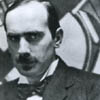Your shopping cart is empty!
Select currency
MENU

A major figure in British art of the first half of the twentieth century, Edward Wadsworth was a painter, printmaker, draughtsman and muralist. He was born in Cleckheaton, Yorkshire, the only son of Fred Wadsworth, a worsted-spinning industrialist who established both Broomfield Mill and the firm E. Wadsworth and Sons.
After schooling in Edinburgh, and contrary to his father's wishes, Edward Wadsworth did not take up work at the mill; he wanted instead to study art. Agreeing a compromise, his father sent him to study machine draughtsmanship at the Knirr School of Art, Munich, with the thought that this would give his son a skill he might apply professionally. In Munich, however, Edward Wadsworth spent as much time exploring non-technical drawing, printmaking and painting as attending to the subject for which he was enrolled. His desire to study painting was only strengthened, and he returned to England, not to take up work as a draughtsman, but to enrol at the Bradford School of Art, before winning a scholarship to attend the Slade School of Art, London (1909-1912).
Edward Wadsworth's oeuvre can be divided into his early Vorticist work; his war work on the dazzle ships; his coal-quarry pen and ink drawings, and his tempera paintings of mostly naval subjects. After the Slade he was enlisted by Wyndham Lewis as a member of the Vorticists; at this point he worked with the woodcut to produce prints of geometrical forms. Through these he sought to venture away from a pedantic realism towards an ever-greater abstraction – a trajectory on which, with occasional retracing of steps and re-visiting of previous vantage points, he would stay. During the war he was contracted to work as a camouflage artist painting the supply ships departing from British ports. These 'dazzle' ships – so called because they were painted so as to frustrate the attempts of the German U-Boat commanders to calculate the speed and course of the merchantmen traversing the seas - would be depicted in several of Wadsworth's works, most notably (see Prints) in two woodcuts: Liverpool Shipping (1918) and Drydocked for Painting and Scaling (1918).
Edward Wadsworth married Fanny Mary in 1912 and they had two children. After the war, however, he left her for the Black Country, for extended excursions to capture coal- quarries, furnaces and slag heaps in a series of ink and wash works which met, when exhibited in the Leicester Galleries 1920, with considerable acclaim. Through this, his first one man show, Wadsworth began to establish himself; but he was yet to find the medium through which he would, for the most part, consolidate his reputation.
In the following year, 1921, Edward Wadsworth's father died. He left a considerable fortune to his son which enabled Edward Wadsworth to travel to Italy where he discovered the medium of tempera. Using tempera he produced, during the twenties, a series of paintings of ports and harbours, one of which, Regalia (1928) was bought by the Tate Gallery.
Edward Wadsworth would continue to use tempera from this point on in his work. By this point, too, he had found the maritime and naval subjects upon which he would most concentrate. He departed, it is true, from the depiction of such imagery when, in the early thirties, he joined the international Abstraction-Creation group, and, at home, Paul Nash's Unit One. His work whilst affiliated with these groups is characterized by more purely abstract depictions – still lifes, often of household objects such as knives or shells (Abstract Design with a Clasp Knife; Composition, French Ruler with Shells, both 1930). And then, at the end of his life, from 1945 till his death in 1949, he would again explore more purely abstract forms. But in the mid-thirties he returned to his maritime subject matter, to semi-abstract images of shipping, quaysides and port facilities, and these paintings are the ones for which Edward Wadsworth is now, perhaps, best known.
Tate Gallery, London; Victoria & Albert Museum, London; National Gallery of Canada, Ottawa; London's Transport Museum; Royal Pavilion of Art, Brighton.
This is a Limited Edition Giclee Print by the artist Edward Wadsworth 350mm x 320mm ..
£138.00 Ex Tax: £115.00
This is a Limited Edition Giclee Print by the artist Edward Wadsworth 350mm x 275mm ..
£138.00 Ex Tax: £115.00